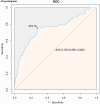Evaluating the prognostic value of systemic immune-inflammatory index in patients with acute decompensated heart failure
- PMID: 38867498
- PMCID: PMC11424332
- DOI: 10.1002/ehf2.14904
Evaluating the prognostic value of systemic immune-inflammatory index in patients with acute decompensated heart failure
Abstract
Aims: The value of the systemic immune-inflammatory index (SII) in assessing adverse outcomes in various cardiovascular diseases has been extensively discussed. This study aims to evaluate the predictive value and risk stratification ability of SII for 30 day mortality in patients with acute decompensated heart failure (ADHF).
Methods: This analysis included 1452 patients hospitalized for ADHF, all the participants being part of the China Jiangxi-acute decompensated heart failure1 project. The risk stratification capability of the SII in patients with ADHF, as well as its correlation with the 30 day mortality risk among ADHF patients, was evaluated utilizing Kaplan-Meier survival analysis and multivariable Cox regression models. A restricted cubic spline was employed to model the dose-response relationship between the two, and the receiver operating characteristic curve was utilized to assess the predictive ability of SII for 30 day mortality.
Results: The Kaplan-Meier analysis revealed that the risk of mortality in the high SII group (SII ≥ 980 × 109/L) was significantly greater than that in the low SII group (SII < 980 × 109/L, log-rank P < 0.001). After adjusting for various confounding factors, a higher SII was associated with an increased risk of 30 day mortality in ADHF patients [hazard ratio (HR) = 2.03, 95% confidence interval (CI): 1.34-3.08]. Further restricted cubic spline analysis revealed a non-linear dose-response relationship between the two (P for non-linear = 0.006). Receiver operating characteristic analysis demonstrated that SII had a high accuracy in predicting 30 day mortality events in ADHF patients (AUC = 0.7479), and the optimal predictive threshold was calculated to be 980 × 109/L, a sensitivity of 0.7547 and a specificity of 0.7234.
Conclusions: This study found a significant positive association between SII and 30 day all-cause mortality in ADHF patients. We determined the SII cut-off point for predicting 30 day all-cause mortality in patients with ADHF to be 980 × 109/L.
Keywords: ADHF; SII; acute decompensated heart failure; short‐term prognostic; systemic immune‐inflammatory index.
© 2024 The Author(s). ESC Heart Failure published by John Wiley & Sons Ltd on behalf of European Society of Cardiology.
Conflict of interest statement
The authors declare that the research was conducted in the absence of any commercial or financial relationships that could be construed as a potential conflict of interest.
Figures




Similar articles
-
The systemic inflammation response index as a significant predictor of short-term adverse outcomes in acute decompensated heart failure patients: a cohort study from Southern China.Front Endocrinol (Lausanne). 2024 Dec 23;15:1444663. doi: 10.3389/fendo.2024.1444663. eCollection 2024. Front Endocrinol (Lausanne). 2024. PMID: 39764249 Free PMC article.
-
Atherogenic index of plasma: a new indicator for assessing the short-term mortality of patients with acute decompensated heart failure.Front Endocrinol (Lausanne). 2024 Jun 10;15:1393644. doi: 10.3389/fendo.2024.1393644. eCollection 2024. Front Endocrinol (Lausanne). 2024. PMID: 38915891 Free PMC article.
-
Admission blood glucose and 30-day mortality in patients with acute decompensated heart failure: prognostic significance in individuals with and without diabetes.Front Endocrinol (Lausanne). 2024 Jul 5;15:1403452. doi: 10.3389/fendo.2024.1403452. eCollection 2024. Front Endocrinol (Lausanne). 2024. PMID: 39036046 Free PMC article.
-
Utility of lung ultrasound to identify patients at risk of rehospitalization for acute decompensated heart failure.Curr Probl Cardiol. 2025 Apr;50(4):103002. doi: 10.1016/j.cpcardiol.2025.103002. Epub 2025 Jan 29. Curr Probl Cardiol. 2025. PMID: 39890047 Review.
-
Risk Factors for All-Cause Mortality in Patients Diagnosed with Advanced Heart Failure: A Scoping Review.J Palliat Med. 2025 Apr;28(4):524-537. doi: 10.1089/jpm.2024.0067. Epub 2024 Jul 31. J Palliat Med. 2025. PMID: 39083426
Cited by
-
Association Between Systemic Immune-Inflammatory Indices and Severity of Coronary Artery Lesions in Patients With Coronary Artery Disease in Different Glucose Metabolic States.J Inflamm Res. 2025 Mar 6;18:3295-3309. doi: 10.2147/JIR.S507696. eCollection 2025. J Inflamm Res. 2025. PMID: 40065907 Free PMC article.
-
Skeletal Muscle Mass and Mortality in Heart Failure: Mediation Role of Systemic Immune-Inflammatory Index.JACC Adv. 2025 Jan 29;4(2):101553. doi: 10.1016/j.jacadv.2024.101553. Online ahead of print. JACC Adv. 2025. PMID: 40014883 Free PMC article.
-
Systemic Immune-Inflammatory Index as a Prognostic Biomarker in Patients with Heart Failure: A Comprehensive Analysis.Clin Appl Thromb Hemost. 2025 Jan-Dec;31:10760296251328361. doi: 10.1177/10760296251328361. Epub 2025 Mar 13. Clin Appl Thromb Hemost. 2025. PMID: 40079806 Free PMC article.
References
-
- Yancy CW, Jessup M, Bozkurt B, Butler J, Casey DE Jr, Colvin MM, et al. 2017 ACC/AHA/HFSA focused update of the 2013 ACCF/AHA guideline for the management of heart failure: A report of the American College of Cardiology/American Heart Association Task Force on Clinical Practice Guidelines and the Heart Failure Society of America. Circulation 2017;136:e137‐e161. doi:10.1161/CIR.0000000000000509 - DOI - PubMed
MeSH terms
Substances
Grants and funding
LinkOut - more resources
Full Text Sources
Medical

